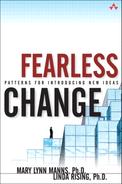Part Two: Experiences
Most of us prefer to learn new ways of doing things by hearing stories. In fact, most human conversation is really story telling. We not only tell stories to each other to explain ideas and relationships, but we also exchange technical expertise in this manner. One researcher found that Xerox copier maintenance personnel shared expertise and helped peers by telling “war stories” of maintenance adventures. We seem to understand how the world works by hearing a story about a specific experience. One study found that people were better able to remember a list of instructions when it was presented as a story. The usual approach of organizing material into categories not only takes time and effort, but the result is a structure that may be more difficult to understand than a story.
Therefore, we present the following stories, or experience reports, in this section to illustrate how our patterns can be used to introduce something new.
- Multiple Sclerosis Society— One woman’s effort to build an international organization involved in research and support for patients with MS.
- UNCA— A medium-sized university introducing a new general education curriculum.
- Sun Core J2EE Patterns— Sun Microsystems, provider of hardware, software, and services, introducing a specialized collection of design patterns.
- Customer Training— Introduction of a new approach at a large avionics company.
We have included these stories for several reasons. First, we want to show you how some people have applied the patterns, in many instances, without knowing they were using them. These experience reports let you read a story about how the patterns are used instead of struggling to make sense of a category, scheme, or diagram. Also, we hope to illustrate, especially if you’re not familiar with patterns, how the use of one pattern can lead to the application of another; in other words, to illustrate a sequence or path through the collection of patterns. Finally, these diverse experience reports demonstrate that people can apply the patterns to fit their own contexts and that the resulting sequence of patterns reflects the individual and the organization. It’s clear that these patterns are useful in many domains. We don’t know anyone who has used all the patterns, but we are happy to be able to include the many different accounts.
